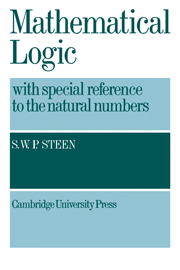Book contents
- Frontmatter
- Contents
- Preface
- Introduction
- Chapter 1 Formal systems
- Chapter 2 Propositional calculi
- Chapter 3 Predicate calculi
- Chapter 4 A complete, decidable arithmetic. The system Aoo
- Chapter 5 Aoo-Definable functions
- Chapter 6 A complete, undecidable arithmetic. The system Ao
- Chapter 7 Ao-Definable functions. Recursive function theory
- Chapter 8 An incomplete undecidable arithmetic. The system A
- Chapter 9 A-Definable sets of lattice points
- Chapter 10 Induction
- Chapter 11 Extensions of the system AI
- Chapter 12 Models
- Epilogue
- Glossary of special symbols
- Note on references
- References
- Index
Chapter 1 - Formal systems
Published online by Cambridge University Press: 07 October 2011
- Frontmatter
- Contents
- Preface
- Introduction
- Chapter 1 Formal systems
- Chapter 2 Propositional calculi
- Chapter 3 Predicate calculi
- Chapter 4 A complete, decidable arithmetic. The system Aoo
- Chapter 5 Aoo-Definable functions
- Chapter 6 A complete, undecidable arithmetic. The system Ao
- Chapter 7 Ao-Definable functions. Recursive function theory
- Chapter 8 An incomplete undecidable arithmetic. The system A
- Chapter 9 A-Definable sets of lattice points
- Chapter 10 Induction
- Chapter 11 Extensions of the system AI
- Chapter 12 Models
- Epilogue
- Glossary of special symbols
- Note on references
- References
- Index
Summary
Nature of a formal system
A formal system is constructed by choosing a set of signs and laying down rules for their manipulation. We have a tape marked into consecutive squares which can always be lengthened, so that we always have vacant squares at the right. The signs are placed on consecutive squares of the tape from left to right, at most one sign to a square. We use capital ell in script type (ℒ) with or without superscripts or subscripts to denote an undetermined formal system.
The signs and symbols
The signs of a formal system ℒ, called ℒ-signs, must be displayed by representative figures and it must be possible to distinguish between them and to recognise them on different occasions and to decide of an object whether it is intended to represent an ℒ-sign or whether it is irrelevant. These conditions are required in order that reading the system be possible. We lack means of displaying an unending list of distinct signs and if we make a list of distinct signs we shall have to stop at some place. Moreover at any stage in our work we shall only require a set of signs that can be displayed, so that the restriction to an initial displayed list of signs is without restriction on our work.
The judgement whether a given mark or figure is intended to represent an ℒ-sign must be left to the reader.
- Type
- Chapter
- Information
- Publisher: Cambridge University PressPrint publication year: 1972

